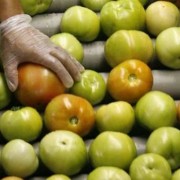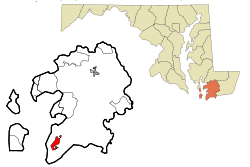Hooper’s Island: The Place that Time Forgot
This summer’s research was focused on Mexican women crab pickers living and working on Hooper’s Island, a chain of three islands located on Maryland’s Eastern Shore. Hooper’s Island is located between the Honga River and Chesapeake Bay, 20 miles south of Cambridge in Dorchester County, Maryland. Hooper’s Island was permanently settled by European colonists in the mid-17th century and issued the earliest land grants in Dorchester County. The island is known for its proximity to the Blackwater Wildlife Refuge, working watermen villages, and the Hooper Island Lighthouse, one of only a few lighthouses constructed on the Eastern Shore in the early 20th century. This remote and sparsely populated (pop. 441) set of islands is home to Maryland’s touristic, economic, and culturally significant oyster and crab industries (See Figure 1).
 Figure1 : Eastern Shore Honga River Map. Image courtesy Kmusser and Wikicommons.
Figure1 : Eastern Shore Honga River Map. Image courtesy Kmusser and Wikicommons.
We accompanied a local mobile clinic that provides outreach and primary care services to migrant camps and crab houses in various counties on the Eastern Shore. The mobile clinic is part of a network of federally-qualified health centers found throughout the upper counties of the Eastern Shore (Caroline, Dorchester, and Talbot counties) that provide medical, dental, and health education to local residents, including migrant and low-income individuals. Migrants are asked to pay an annual fee of $15 for all services and, during the summer months, receive follow-up care visits and prescriptions delivered to them on Hooper’s Island. Each mobile clinic consisted of a medical assistant, one or two Spanish interpreters, and a nurse practitioner. The clinic staff scheduled several visits to each crab house on a weekly basis to administer basic triage and deliver prescription medications to workers.
 Mobile Dental and Medical Clinic, Hooper’s Island.
Mobile Dental and Medical Clinic, Hooper’s Island.
The vast majority of the migrants who work for the crab companies are Mexican women, recruited in Mexico that enter the United States through the H-2B visa program. The H-2B visa permits U.S. employers to recruit foreign workers in non-agricultural work after they provide sufficient evidence that they are unable to find enough domestic workers for these specific jobs. The women then make a multi-day trip by bus to the Eastern Shore and are assigned housing once they arrive.
The women reside full-time on Hooper’ Island from April to November and work for the crab companies while living in shared residences that are rented to them by the employers for approximately $45 a week. As we discovered last summer while exploring the rural landscape of Hooper’s Island, it is fairly isolated. The women we interviewed spoke about enduring the psychological and physical isolation away from loved ones, sharing small bedrooms with three or more people, and being placed in uncomfortable housing arrangements with as many as 20 women.
 Seafood Worker Housing, Hooper’s Island.
Seafood Worker Housing, Hooper’s Island.
In one four-bedroom house we visited, 16 women shared one bathroom and had to bathe in shifts. They complained of chinches, or bed bugs, biting them at all hours of the night. A young woman told me that she would try to sleep during the day when the bedbugs were less active. Nonetheless, the women had to deal with the arrangements in order to make the much needed money to support their families in Mexico.
The lack of available public transportation discourages the women from leaving the island and even their homes. Many migrant houses are a 20 minute drive away from the nearest store or restaurant. The summertime heat also prevents the women from walking this distance. During the rainy season, high tides and storms flood roads and close bridges. The women were solely reliant on their employers and acquaintances for transportation to buy food, medication, and supplies.
A young woman we spoke to who began working in the crab house in late June had difficulties acclimating to the area. Locals who she encountered were polite but colder than she was used to. She didn’t speak English and no one spoke Spanish. She felt no sense of community. Walking down the deserted streets for the first time she aptly described Hooper’s Island as “the place time forgot.”
Each seafood company sets its own work schedule but the women typically begin as early as 2:00AM each day, working five 8-hour shifts a week. The pay is minimum wage or piece rate of approximately $2.00 per pound, whichever is greater. Overtime is heavily dependent on the weekly catch and labor needed to fill quotas and orders from wholesalers.
Women usually purchase their own tools and gloves from the employer and sit or stand at long stainless steel tables, piled high with cooled, cooked crab. They work methodically and very quickly, breaking off legs, removing innards, and separating backfin from jumbo lump meat. The work continues for eight hours with the women taking staggered breaks until all crabs are picked clean.
 Crab Pickers at Work, Hooper’s Island.
Crab Pickers at Work, Hooper’s Island.  Freshly Steamed Crab Ready to be Processed.
Freshly Steamed Crab Ready to be Processed.
While assessing the medical needs of the crab pickers, we discovered a number of occupational hazards that were faced by the women. The crabs were dipped in a chlorine wash in industrial-sized steamers. Wearing gloves and masks helped protect them from the chemical to a degree but not all the companies provided these items without charging the women. In addition, the gloves prevented women from working quickly enough to make their allotted quota of 24 pounds per day. Common symptoms for which the women sought medical care included skin rashes, fungus between fingers and toes, sore throats, widespread itchiness, and respiratory ailments like asthma. We were also told that Vitamin D deficiency was a noticeable issue for many of the women. This may be due to long hours of indoor work or sleep during daytime hours. The major cause of vitamin D deficiency in humans is the lack of sun exposure. Although you can get vitamin D from food, these are often inadequate to satisfy the needs of your body. Vitamin D deficiency causes rickets in children and can lead to osteoporosis and fractures in adults. Vitamin D deficiency has also been associated with increased risk of cancer, autoimmune diseases, hypertension, and infectious diseases.
 Migrant Clinic Dental Screening.
Migrant Clinic Dental Screening.  Seafood Worker Receiving a Nebulizer Treatment
Seafood Worker Receiving a Nebulizer Treatment  Migrant Clinic Staff Preparing a Rapid Strep Test
Migrant Clinic Staff Preparing a Rapid Strep Test



 Crisfield, MD
Crisfield, MD Crisfield Clinic
Crisfield Clinic tomato crops
tomato crops Lunch in Crisfield
Lunch in Crisfield Wild ponies on Assateague Island
Wild ponies on Assateague Island Assateague Island lighthouse
Assateague Island lighthouse The Delmarva Peninsula
The Delmarva Peninsula
 Mountaire job billboard
Mountaire job billboard Mountaire’s poultry plant separated only by a chain link fence from the Indian River School complex.
Mountaire’s poultry plant separated only by a chain link fence from the Indian River School complex. Tomato plants in the fields
Tomato plants in the fields